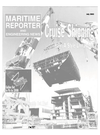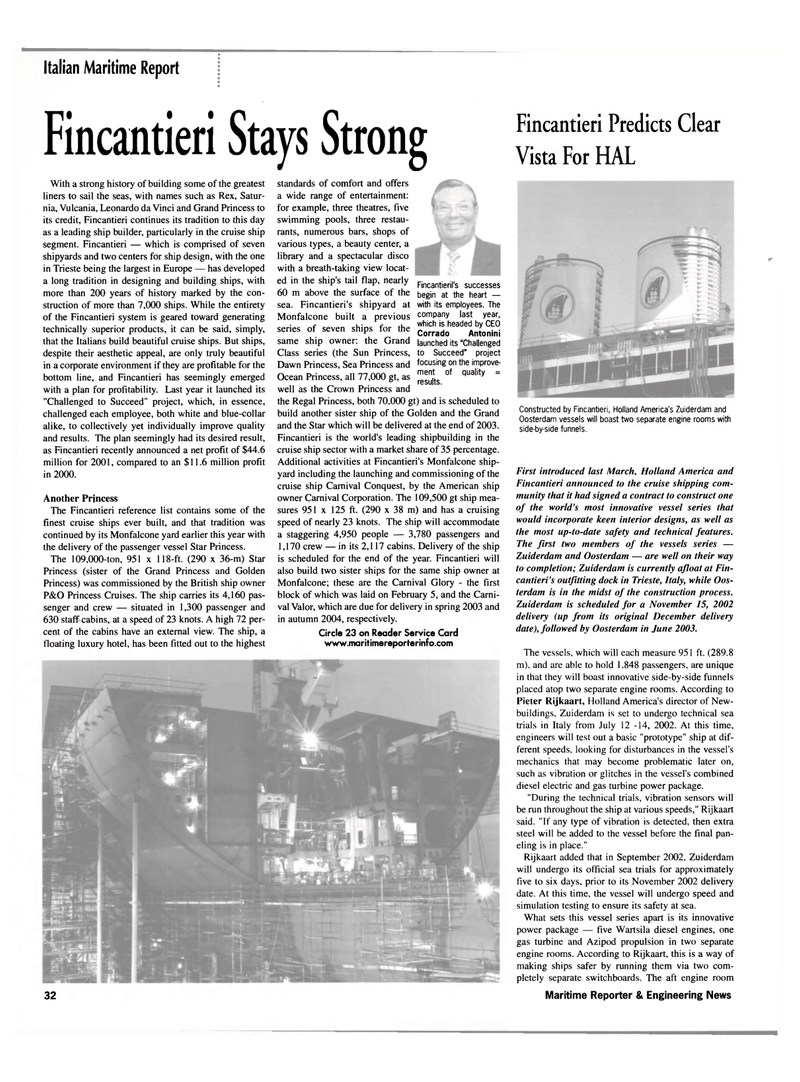
Page 32: of Maritime Reporter Magazine (July 2002)
Read this page in Pdf, Flash or Html5 edition of July 2002 Maritime Reporter Magazine
Italian Maritime Report j
Fincantieri Stays Strong
With a strong history of building some of the greatest liners to sail the seas, with names such as Rex, Satur- nia, Vulcania, Leonardo da Vinci and Grand Princess to its credit, Fincantieri continues its tradition to this day as a leading ship builder, particularly in the cruise ship segment. Fincantieri — which is comprised of seven shipyards and two centers for ship design, with the one in Trieste being the largest in Europe — has developed a long tradition in designing and building ships, with more than 200 years of history marked by the con- struction of more than 7,000 ships. While the entirety of the Fincantieri system is geared toward generating technically superior products, it can be said, simply, that the Italians build beautiful cruise ships. But ships, despite their aesthetic appeal, are only truly beautiful in a corporate environment if they are profitable for the bottom line, and Fincantieri has seemingly emerged with a plan for profitability. Last year it launched its "Challenged to Succeed" project, which, in essence, challenged each employee, both white and blue-collar alike, to collectively yet individually improve quality and results. The plan seemingly had its desired result, as Fincantieri recently announced a net profit of $44.6 million for 2001, compared to an $11.6 million profit in 2000.
Another Princess
The Fincantieri reference list contains some of the finest cruise ships ever built, and that tradition was continued by its Monfalcone yard earlier this year with the delivery of the passenger vessel Star Princess.
The 109,000-ton, 951 x 118-ft. (290 x 36-m) Star
Princess (sister of the Grand Princess and Golden
Princess) was commissioned by the British ship owner
P&O Princess Cruises. The ship carries its 4,160 pas- senger and crew — situated in 1,300 passenger and 630 staff cabins, at a speed of 23 knots. A high 72 per- cent of the cabins have an external view. The ship, a floating luxury hotel, has been fitted out to the highest standards of comfort and offers a wide range of entertainment: for example, three theatres, five swimming pools, three restau- rants, numerous bars, shops of various types, a beauty center, a library and a spectacular disco with a breath-taking view locat- ed in the ship's tail flap, nearly 60 m above the surface of the sea. Fincantieri's shipyard at
Monfalcone built a previous series of seven ships for the same ship owner: the Grand
Class series (the Sun Princess,
Dawn Princess, Sea Princess and
Ocean Princess, all 77,000 gt, as well as the Crown Princess and the Regal Princess, both 70,000 gt) and is scheduled to build another sister ship of the Golden and the Grand and the Star which will be delivered at the end of 2003.
Fincantieri is the world's leading shipbuilding in the cruise ship sector with a market share of 35 percentage.
Additional activities at Fincantieri's Monfalcone ship- yard including the launching and commissioning of the cruise ship Carnival Conquest, by the American ship owner Carnival Corporation. The 109,500 gt ship mea- sures 951 x 125 ft. (290 x 38 m) and has a cruising speed of nearly 23 knots. The ship will accommodate a staggering 4,950 people — 3,780 passengers and 1,170 crew — in its 2,117 cabins. Delivery of the ship is scheduled for the end of the year. Fincantieri will also build two sister ships for the same ship owner at
Monfalcone; these are the Carnival Glory - the first block of which was laid on February 5, and the Carni- val Valor, which are due for delivery in spring 2003 and in autumn 2004, respectively.
Circle 23 on Reader Service Card www.maritimereporterinfo.com
Fincantieril's successes begin at the heart — with its employees. The company last year, which is headed by CEO
Corrado Antonini launched its "Challenged to Succeed" project focusing on the improve- ment of quality = results.
Fincantieri Predicts Clear
Vista For HAL
Constructed by Fincantieri, Holland America's Zuiderdam and
Oosterdam vessels will boast two separate engine rooms with side-by-side funnels.
First introduced last March, Holland America and
Fincantieri announced to the cruise shipping com- munity that it had signed a contract to construct one of the world's most innovative vessel series that would incorporate keen interior designs, as well as the most up-to-date safety and technical features.
The first two members of the vessels series —
Zuiderdam and Oosterdam — are well on their way to completion; Zuiderdam is currently afloat at Fin- cantieri's outfitting dock in Trieste, Italy, while Oos- terdam is in the midst of the construction process.
Zuiderdam is scheduled for a November 15, 2002 delivery (up from its original December delivery date), followed by Oosterdam in June 2003.
The vessels, which will each measure 951 ft. (289.8 m), and are able to hold 1.848 passengers, are unique in that they will boast innovative side-by-side funnels placed atop two separate engine rooms. According to
Pieter Rijkaart, Holland America's director of New- buildings, Zuiderdam is set to undergo technical sea trials in Italy from July 12 -14, 2002. At this time, engineers will test out a basic "prototype" ship at dif- ferent speeds, looking for disturbances in the vessel's mechanics that may become problematic later on, such as vibration or glitches in the vessel's combined diesel electric and gas turbine power package. "During the technical trials, vibration sensors will be run throughout the ship at various speeds," Rijkaart said. "If any type of vibration is detected, then extra steel will be added to the vessel before the final pan- eling is in place."
Rijkaart added that in September 2002, Zuiderdam will undergo its official sea trials for approximately five to six days, prior to its November 2002 delivery date. At this time, the vessel will undergo speed and simulation testing to ensure its safety at sea.
What sets this vessel series apart is its innovative power package — five Wartsila diesel engines, one gas turbine and Azipod propulsion in two separate engine rooms. According to Rijkaart, this is a way of making ships safer by running them via two com- pletely separate switchboards. The aft engine room 32 Maritime Reporter & Engineering News

 31
31

 33
33
